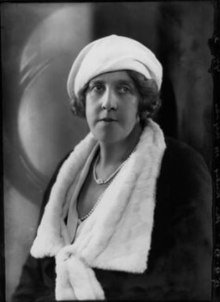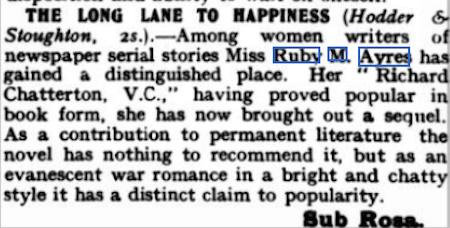Book review by George Simmers: The Great War came as something of a boon to romantic novelists. It offered dramatic new ways of refreshing all their favorite tropes: separation, misunderstanding, yearning,suffering. Ruby M. Ayres was a successful magazine writer before the war began, but Richard Chatterton V.C. made her reputation. It began as a serial in the Daily Mirror in April 1915. (The Mirror was an illustrated paper aimed largely at a female readership.) Published as a book by Hodder and Stoughton, it went on to be a best-seller.
 Ruby Mildred Ayres (1881 – 1955)
Ruby Mildred Ayres (1881 – 1955)
The basis of the plot is simple: Richard Chatterton is considerd a ‘slacker’ because he does not enlist. His motives are not explored very fully, except that he is a complacent young man with a comfortable life; he is not carried along by the popular enthusiasm for the war, which does not seem to be his business. He is also complacent about his love-life, since he is engaged to a lovely heiress whose fortune will help to restore his own prospects.
He is disturbed when he hears men at his club dismissing him as a ‘shirker’, and even more so when Sonia, his fiancée, repeats their ctiticisms. The couple argue, and she breaks off the engagement. The rest of the novel will show the destruction of Chatterton’s complacency, and the making of him as a ‘man’. The novel’s epigraph runs:
A laggard in Love and a laggard in war:
What did they give him his manhood for?
Most of the book is about Sonia. Having broken off the engagement, on the rebound she becomes attached to Montague (who cannot enlist because his leg was injured in a car accident). Yet her instincts mean thatbshe is still attracted to Chatterton, even after committing herself to his rival.
Ayres plays every trick in the romantic novelist’s handbook to keep the couple apart. Chatterton goes to France of course – significantly enlisting as a Tommy rathe than waiting to get a commission (a proof of his sincerity). He asks his friend to keep the knowledge of this from Sonia; he does not want to seem to be merely trying to impress her. Montague pressures her to marry him, and again and again she almost agrees, as her sense of obligation fights with her instinct. Chatterton comes home briefly, wounded, but misunderstandings keep the pair apart, and she becomes jealous of the pretty young nurse who is tending him. She believes he is dead; he believes she is married; misunderstanding piles on misunderstanding.
The will-they won’t-they suspense is kept up brilliantly until page 291 of this 292-page novel. Then, as we sort of knew they would from the start, they come fully and unambiguously together.
The book is formulaic, but it is not stupid. It deals with a real issue that was troubling women in 1915: should you encourage your man to enlist or try to prevent him? It does not offer easy answers; the question seems simple to Sonia at the start – but later she comes to realize the pain and horror that war can mean.
The book has plenty of clichés, but it also does its bit to warn against clichés. Sonia is often made to feel the difference between newspaper version of the war and the reality:
She had never seen anything like this before. She had often read of the farewell scenes at the differentstations as portrayed by the picturesque pen of a news-paper man, but somehow she had never realized the vivid reality of it all; never properly understood the thrill of mingled pride and anguish that every woman in that crowd must be experiencing.
The novel is very like what civilian life must have been in 1915 – a lot of people involved in their own affairs, expressing opinions, hopes and fears, with interruptions from the war, of bits of terrifying reality.
A couple of chapters are set in the trenches. A military historian could probably pick holes in their description of trench routine, but they are generally convincingly presented (mostly through the eyes and thoughts of Richard Chatterton. The presentation of Chatterton is interesting; he enlisted as a Tommy (which shows him rising above a mere class identity) but in the book’s big action episode, when he rescues a man from No-Man’s-Land under fire,the man he rescues is Carter, his pre-war valet. So though he is a valet, he is acting with the noblesse oblige of the ideal officer. In the process of becoming a man rather than a ‘slacker’ he has cast away the trappings of his class identity, and yet has proved himself worthy of it. After he has won the V.C. he is fast-tracked for a commission.
The book is an exciting read, but in 1915 would also have been a thought-provoking one. It encourages the reader to share the view: ‘Richard Chatterton should go to war’ – but then shows what that means in practice – danger, hardship and wounds. It is a book that goes against easy answers. (Though of course we do get, eventually, the standard proper happy ending.)
At our Sheffield meeting on Tuesday, discussing various novels by Ayres, some people expressed surprise that her books did not offer the easy erotic fantasies of more typical romances. There were, for example, rather grim books about unsatisfactory marriages. But I think that Ayres was often using the romance form to explore subjects that trouble her readers, who did not read her for light thrills, but precisely because she was writing about difficult subjects – maybe in the spirit in which we all enjoy breading the agony aunts’ advice columns; it’s good to see the problems other people have – but sometimes we read something that makes us reflect on our own lives. My guess is that Ayres had internalised the rules of the romance novel so well that she was able to use them to deal with any subject that interested her.
Richard Chatterton V.C. Was so successful that Ayres almost immediately began work on a sequel to it (The Long Lane to Happiness, also published in 1915). How on earth do you have a sequel to a romance that has ended, finally, with the hero and heroine coming together forever? Easy. In The Long Lane to Happiness Chatterton succumbs to shell-shock and loses his memory. His romantic troubles can start all over again. I found a snooty review of this sequel in the Gentlewoman magazine, which I rather like:

